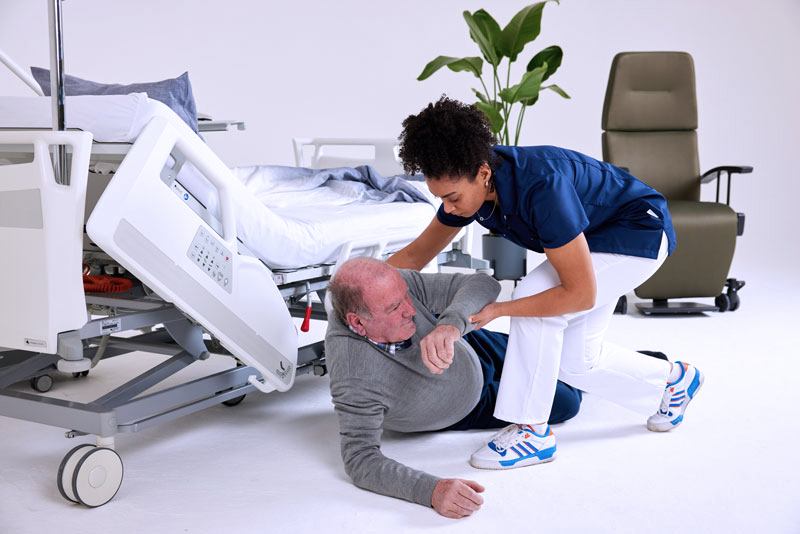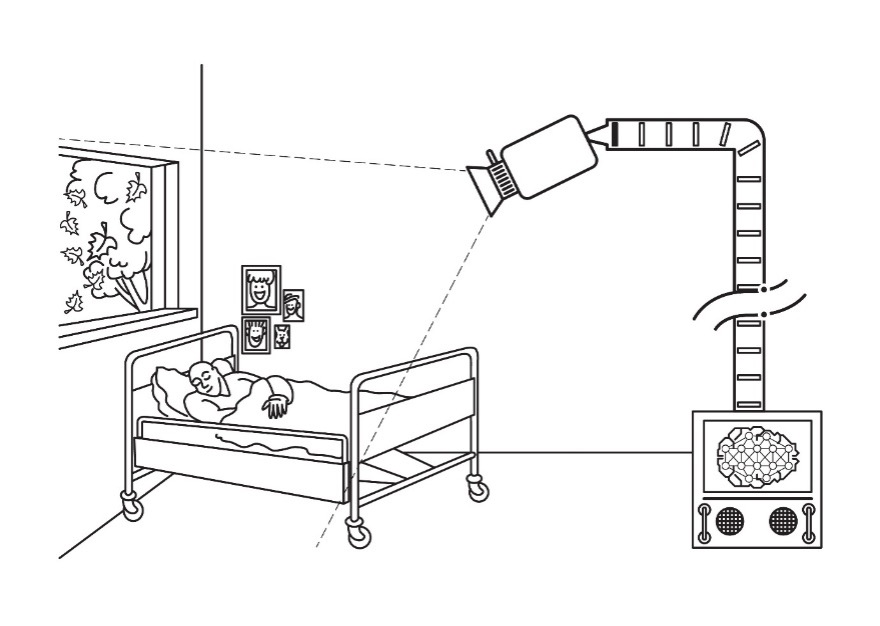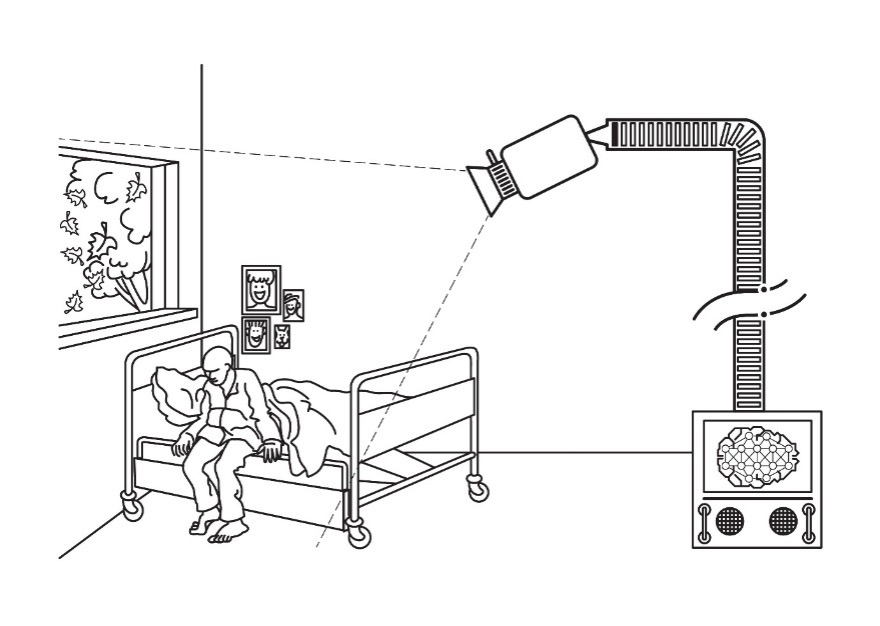
Four Ways to Improve the Response Time to Falls in Care Facilities.
Shortening the factory setting of a fall alarm sensor is like rearranging the deck chairs of the sinking Titanic. You miss the more significant issues. Instead, care home management should prevent the crash with the iceberg altogether. How? In this article, I explain more effective ways to improve fall response times. All sorts of sensors are used to improve the provision of care to older residents in care homes. Many of them are based on motion sensing. If a resident tries to get out of bed, the motion sensor next to the bed instantly detects this and sends an alarm to the nurse on duty. However, these sensors generate many false alarms, such as when a cat jumps on the bed. This results in caregiver alarm fatigue.
At Kepler Vision Technologies, we develop software that makes optical sensors “smart.” We do so using modern artificial intelligence. In contrast to old-fashioned motion sensors, our software can articulate what goes on in a room. Typical users of our solution are long-term care facilities such as Domidep in France and Oktober in the Netherlands, as well as hospitals like University Hospital Brussels in Belgium and University Hospital Groningen in the Netherlands.
To quote one of our customers, long-term care facility Magentazorg:
“With Kepler’s software, we are experiencing a massive drop in the number of alarms – and the few alarms we still get now really matter.”
We investigated the most important drivers for faster and more reliable alarms. I will describe them in detail in the following few paragraphs. I ordered these drivers according to their effect. The last one has the most impact and may surprise you.
Fourth Place (Send Alarms Up To 50 Seconds Faster): Change Time-Delay Factory Settings
You want to shorten the time a fallen resident waits for help on the floor. Logically, you set the fall alarm time delay to the shortest interval possible. This may seem like the obvious answer, but faster alerts create reliability issues. Fast alarms and reliable alarms are conflicting requirements. Let me explain why.
Once our software detects a person has fallen, it searches for confirmation in subsequent video frames. Taking into account more evidence implies more reliable results. It also means it takes longer before an alarm can be sent out.
Shortening the time delay results in faster alarms at the cost of increasing the number of false alarms. Consider the measurements we made below to illustrate this. Table 1 clearly shows the conflict between responsiveness (time delay) and reliability (false alarm rate).
 Table 1: We conducted this experiment with seventy-four sensors over two weeks. Most false alarms are due to staff crouching or kneeling before a resident. These alarms can be switched off if needed. This customer likes the false alarms because they prove to the staff at work that the system is still up and running.
Table 1: We conducted this experiment with seventy-four sensors over two weeks. Most false alarms are due to staff crouching or kneeling before a resident. These alarms can be switched off if needed. This customer likes the false alarms because they prove to the staff at work that the system is still up and running.
The table also shows that our software’s reliability is fantastic, even at shorter delays. These results are achieved by training our neural networks on large amounts of data we have accumulated over the years and continuously upgrading our software to the latest neural network architectures.
Third Place (Send an Alarm After 10 Seconds): Switch on Kepler’s Turbo Alarm Mode
We introduced a turbo mode in our server software to cater to customers who want to get alarms as fast as possible when a resident has fallen. The turbo mode generates a reliable alarm within 10 seconds. This is achieved by changing the sampling rate depending on a person’s activities. In other words, when a resident is lying safely in bed, we slow down the sampling rate, but when the person tries to get out of bed or seems to have fallen, we speed up the sampling rate to gather evidence faster. Figures 1 and 2 illustrate the concept.
We have patented this solution under application number US20240193994A1.

Figure 1: If a person is lying in bed, the sampling rate of smart sensors is lowered.
Figure 2: : If a resident performs potentially dangerous activities, the smart sensor increases its sampling rate to get help from a nurse more rapidly, if needed.
Table 2 illustrates the effect of turbo mode. Turbo mode decreases the number of false alarms by 100%.

Table 2: We conducted the “turbo mode off” experiment with seventy-four sensors over two weeks and the “turbo mode on” experiment with 95 sensors again over two weeks.
Second Place (Gets Help 5 to 10 Minutes Faster): Discuss Slow Response Causes With Caregivers.
In one of our white papers, we measured how long it takes for a caregiver to arrive after they receive an alarm. We found that it sometimes takes three or even four minutes before a nurse arrives. We repeated the experiment three more times. The outcomes are in the appendix in Tables 4, 5 and 6. To summarize, it can take over 20 minutes before help arrives in case of a fall. The management of care locations should discuss with their caregivers what can be done to increase responsiveness.
Still, the reaction time of caregivers does not have the most significant effect. Read on.
First Place (Gets Help Up To An Hour Faster): Fix Network Outages
We have tested the network quality of over 100 care locations. For a month, we measured the number of times an elderly care location had a network outage lasting more than an hour. Of course, this should never happen: If the resident happens to fall when the network is down, no alarm message will be sent.
Table 3 lists what happens in practice.
 Table 3: This experiment lasted from December 9, 2024, until January 9, 2025. We measured the number of network outages lasting more than one hour at elderly care locations. These numbers are shocking.
Table 3: This experiment lasted from December 9, 2024, until January 9, 2025. We measured the number of network outages lasting more than one hour at elderly care locations. These numbers are shocking.
Fixing these network outages will significantly reduce the time a fallen resident waits for help.
What You, The Care Home Manager, Should Do Next
Remember: Shortening the fall alarm time delay by nurses is like rearranging the deck chairs of the sinking Titanic. It does not make much sense to set the alarm delay from 30 to 10 seconds if it takes the network more than an hour to broadcast the alarm.
First, checking and fixing the quality of your network has the most impact if you want to reduce the time before a fallen resident is found. We’ve seen networks go down when:
1. A network or firewall update was scheduled, but the system integrator forgot to communicate this.
2. There was a power failure, and no UPS (uninterruptable power supply) was available.
3. The network’s bandwidth was overstretched, and a decision had to be made to watch television or enable remote patient monitoring. TV won.
These types of reasons for network failure are not difficult to overcome.
Why do some facilities always have networking issues while others don’t? The system integrator responsible for the best-performing network uptime told me their technical staff always needs to get up and fix network failures at night. Ever since installing this procedure, the number of network failures decreased rapidly.
The second thing to do is to get the caregivers to respond faster to alarms. This may be more difficult to fix as I don’t know what the caregiver was doing when they received the alarm. I spoke with one of the ward managers of the night shift discussed in this document. He told me of a few possible cases:
1. Looking at the data usage of the caregiver’s iPad, the caregiver may have been watching television and not paying attention to the alarm.
2. It sometimes happens that caregivers fall asleep at night.
3. If the caregiver was on duty alone, they may have been bringing another resident to the bathroom and they could not leave that resident alone.
This last reason will be difficult to overcome. The first two reasons are not.
Lastly, I showed that the Kepler turbo mode can improve the alarms’ reliability and time of arrival. This way, we chop off the delay’s last seconds, helping fallen residents get help faster.
Send me a private message if you have any questions.
We provide licenses to our software and patent portfolio. We are also eager to connect you with our growing ecosystem of international partners: Our technology, along with your efforts, helps you provide the best care possible. Our technology is sold through system integrators like Mobotix, Konica Minolta, Vinci Energies, and KPN Health. The messages generated by Kepler’s technology are sent to the nurses’ phones using nurse call systems like IQMessenger, Alcatel Lucent, and Ascom.
 Table 4: How long does it take for a nurse to arrive after a resident falls? In this experiment, the maximum time was 21 minutes.
Table 4: How long does it take for a nurse to arrive after a resident falls? In this experiment, the maximum time was 21 minutes.
 Table 5: We measured the time it takes for a nurse to arrive at a different care location. Here, the maximum time was 7 minutes. The nurse’s arrival after 0 seconds means the nurse dropped the client.
Table 5: We measured the time it takes for a nurse to arrive at a different care location. Here, the maximum time was 7 minutes. The nurse’s arrival after 0 seconds means the nurse dropped the client.
 Table 6: We also measured the time at a different nursing home. Here, the maximal time was 14 minutes. There are three alarms denoted with a *. This was the same resident who apparently fell three times that day! Luckily, each time, the resident was found within two minutes.
Table 6: We also measured the time at a different nursing home. Here, the maximal time was 14 minutes. There are three alarms denoted with a *. This was the same resident who apparently fell three times that day! Luckily, each time, the resident was found within two minutes.
This article appeared first on LinkedIn; here is the link.